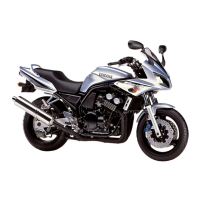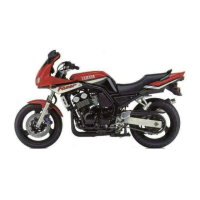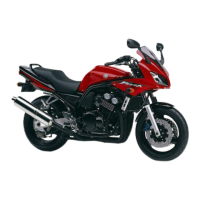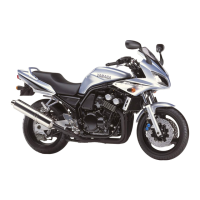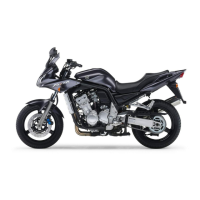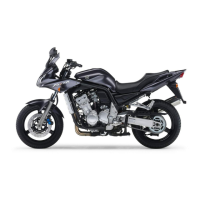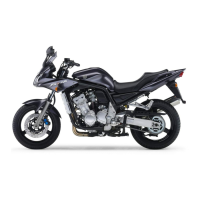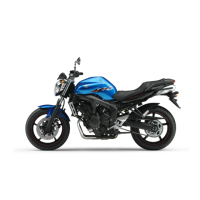Do you have a question about the Yamaha FZS600'98 and is the answer not in the manual?
Lists dimensions, engine type, displacement, bore, stroke, and other general specifications.
Provides standard and limit values for engine components like cylinder head warp and camshaft dimensions.
Specifies torque values for engine components during assembly and disassembly.
Lists specifications for ignition, charging, lighting, and starting systems.
Specifies general tightening torques for standard fasteners based on ISO thread pitch.
Outlines recommended service intervals for various maintenance and lubrication jobs.
Covers engine-related inspections and adjustments, including valve clearance and carburetor synchronization.
Provides a detailed procedure for measuring and adjusting valve clearances on a cold engine.
Explains how to synchronize the carburetors using vacuum gauges and an engine tachometer.
Describes how to measure engine compression pressure to diagnose performance issues.
Provides step-by-step instructions for draining and replacing engine oil and filter.
Explains how to measure engine oil pressure to diagnose lubrication system faults.
Guides on adjusting the clutch cable free play for optimal clutch operation.
Provides a procedure for removing air from the hydraulic brake system.
Covers removal, checking, and installation of cylinders, pistons, and piston rings.
Covers disassembly, checking, and assembly of the crankcase halves.
Details removal, checking, and installation of the crankshaft and connecting rods.
Covers removal, disassembly, assembly, installation, and adjustment of the carburetors.
Guides on measuring and adjusting the fuel level within the carburetor float chambers.
Covers inspection and replacement of brake pads, master cylinders, and calipers.
Provides detailed wiring diagrams for the motorcycle's electrical systems.
Covers the ignition system's circuit diagram, troubleshooting steps, and component checks.
Details the starting system's circuit diagram, operation, and troubleshooting procedures.
Covers the charging system's circuit diagram, troubleshooting, and component checks.
Details the lighting system's circuit diagram, troubleshooting for various lights, and checks.
Covers the signal system's circuit diagram and troubleshooting for lights, horn, and switches.
Explains the motorcycle's self-diagnosis feature and how to interpret condition codes.
Lists potential causes for starting difficulties related to fuel, electrical, compression, and carburetor systems.
Lists potential causes for engine overheating, including ignition, fuel, cooling, and engine oil issues.
Identifies causes for poor braking effect, related to brake discs, fluid, calipers, and hoses.
Covers potential causes for unstable handling related to tires, wheels, suspension, frame, and steering.
Lists dimensions, engine type, displacement, bore, stroke, and other general specifications.
Provides standard and limit values for engine components like cylinder head warp and camshaft dimensions.
Specifies torque values for engine components during assembly and disassembly.
Lists specifications for ignition, charging, lighting, and starting systems.
Specifies general tightening torques for standard fasteners based on ISO thread pitch.
Outlines recommended service intervals for various maintenance and lubrication jobs.
Covers engine-related inspections and adjustments, including valve clearance and carburetor synchronization.
Provides a detailed procedure for measuring and adjusting valve clearances on a cold engine.
Explains how to synchronize the carburetors using vacuum gauges and an engine tachometer.
Describes how to measure engine compression pressure to diagnose performance issues.
Provides step-by-step instructions for draining and replacing engine oil and filter.
Explains how to measure engine oil pressure to diagnose lubrication system faults.
Guides on adjusting the clutch cable free play for optimal clutch operation.
Provides a procedure for removing air from the hydraulic brake system.
Covers removal, checking, and installation of cylinders, pistons, and piston rings.
Covers disassembly, checking, and assembly of the crankcase halves.
Details removal, checking, and installation of the crankshaft and connecting rods.
Covers removal, disassembly, assembly, installation, and adjustment of the carburetors.
Guides on measuring and adjusting the fuel level within the carburetor float chambers.
Covers inspection and replacement of brake pads, master cylinders, and calipers.
Provides detailed wiring diagrams for the motorcycle's electrical systems.
Covers the ignition system's circuit diagram, troubleshooting steps, and component checks.
Details the starting system's circuit diagram, operation, and troubleshooting procedures.
Covers the charging system's circuit diagram, troubleshooting, and component checks.
Details the lighting system's circuit diagram, troubleshooting for various lights, and checks.
Covers the signal system's circuit diagram and troubleshooting for lights, horn, and switches.
Explains the motorcycle's self-diagnosis feature and how to interpret condition codes.
Lists potential causes for starting difficulties related to fuel, electrical, compression, and carburetor systems.
Lists potential causes for engine overheating, including ignition, fuel, cooling, and engine oil issues.
Identifies causes for poor braking effect, related to brake discs, fluid, calipers, and hoses.
Covers potential causes for unstable handling related to tires, wheels, suspension, frame, and steering.
| Displacement | 599 cc |
|---|---|
| Bore x stroke | 62.0 mm x 49.6 mm |
| Compression ratio | 12.0:1 |
| Starting system | Electric |
| Clutch | Wet, multi-plate |
| Final drive | Chain |
| Rear tyre | 160/60 ZR17 |
| Engine Type | Liquid-cooled, 4-stroke, DOHC, inline-4 |
| Fuel system | Carburetor |
| Ignition | Digital TCI |
| Max. power | 95 hp @ 11, 500 rpm |
| Max. torque | 61 Nm @ 9, 500 rpm |
| Transmission | 6-speed |
| Frame type | Deltabox |
| Front suspension | Telescopic fork |
| Rear suspension | Swingarm, mono-shock |
| Front brakes | Dual hydraulic disc, 298 mm |
| Rear brakes | Single hydraulic disc, 245 mm |
| Front tyre | 120/60 ZR17 |
| Seat height | 790 mm |
| Fuel capacity | 18 L (4.8 US gal) |
| Dry weight | 189 kg |
| Ground Clearance | 135 mm |
